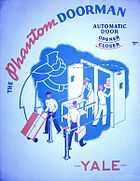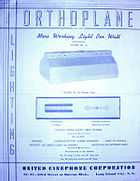George Devol
| George Charles Devol, Jr | |
|---|---|
 George Devol in 1982 | |
| Born |
February 20, 1912 Louisville, Kentucky |
| Died |
August 11, 2011 (aged 99) Wilton, Connecticut |
| Occupation | Inventor, entrepreneur |
| Spouse(s) | Evelyn Ruth Devol (Jahelka) |
George Charles Devol, Jr. (February 20, 1912 – August 11, 2011) was an American inventor who was awarded the patent for Unimate, the first industrial robot. Devol's patent for the first digitally operated programmable robotic arm represented the foundation of the modern robotics industry.[1]
As an inventor he had over 40 patents and was president of Devol Research. Devol has resided in Fort Lauderdale, Florida and Wilton, Connecticut operating a robot consulting business.[2]
Biography
Born in Louisville, Kentucky in 1912, Devol was interested from boyhood in all things electrical and mechanical such as boats, airplanes, and engines.
He got some practical experience at Riordan Prep, where, in addition to studying traditional subjects, he helped construct some buildings and run the school's electric light plant. Although he wasn't very scholarly he read everything he could about mechanical devices, trying to discover what, besides building radios, could be done with vacuum tubes when applied as control devices.
United Cinephone
Choosing to forego higher education, in 1932 Devol went into business, forming United Cinephone to produce variable area recording directly onto film for the new sound motion pictures ("talkies"). However, he later learned that companies like RCA and Western Electric were working in the same area, and decided to discontinue the product.

At that time, Devol asked himself "what else can we do with all these photocells and vacuum tubes?"
Devol decided that United Cinephone needed inventions in order to sell its photoelectric switches. One of Devol's first inventions was the automatic door. United Cinephone licensed Devol's invention to Yale & Towne who manufactured the "Phantom Doorman" photoelectric door. This was the first automatic opening door, now ubiquitous in grocery stores and elsewhere. United Cinephone also manufactured many of its own products using photoelectric cells and vacuum tube control systems. Among these was a very early bar code system that was used for sorting packages at the Railway Express Company, years before others would separately come up with similar technology.

In 1939 United Cinephone installed automated photoelectric counters at New York World's Fair to count customers entering the fairgrounds.
World War II
In 1939, Devol applied for a patent for proximity controls for use in laundry press machines, based on a radio frequency field. This control would automatically open and close laundry presses when workers approached the machines. Once the war began, Devol was advised by the patent office that his patent application would be placed on hold for the duration of the conflict.
Around the time the World War II began, Devol sold his interest in United Cinephone and approached Sperry Gyroscope to see if they were interested in his ideas on radar technology. He was retained by Sperry as manager of the Special Projects Department that developed radar devices and microwave test equipment.
Later in the war, he approached Auto-Ordnance Company regarding products that company could produce aside from their primary product line, which were Thompson submachine guns. Devol told them that the field of radar counter-measures was about to emerge as an urgently needed defense technology.
In 1943, he organized General Electronics Industries in Greenwich, Connecticut, as a subsidiary of the Auto Ordinance Corporation. General Electronics produced counter-radar devices until the end of the War. General Electronics was one of the largest producers of radar and radar counter-measure equipment for the U.S. Navy, U.S. Army Air Force and other government agencies. The company's radar counter-measure systems were on allied planes on D-Day.
Over a difference of opinion regarding the future of certain projects, Devol resigned from Auto Ordinance and joined RCA. After a short stint as eastern sales manager of electronics products, which he felt "wasn't his ball of wax", Devol left RCA to develop ideas that eventually led to the patent application for the first industrial robot. In 1946 he applied for a patent on a magnetic recording system for controlling machines and a digital playback device for machines.
Other post-war work

Devol was part of the team that developed the first commercial use of microwave oven technology, the Speedy Weeny, which automatically cooked and dispensed hotdogs in places such as Grand Central Terminal.
In the early 1950s, Devol licensed his digital magnetic recording device to Remington Rand of Norwalk, CT and became manager of their magnetics department. There he worked with a team to develop his magnetic recording system for business data applications. He also worked on developing the first high-speed printing systems. While the magnetic recording system proved too slow for business data, Devol's invention was re-purposed as a machine control that would eventually become the "brains" of the Unimate robot.
The first industrial robot: Unimate

In the 1940s, Devol wasn't thinking about robots. Instead, he was focusing on manipulators and his patent on magnetic recording devices. He felt the world was ready for new ideas as he saw the introduction of automation into factories during this time.
In 1954, Devol applied for patent on Programmed Article Transfer that introduced the concept of Universal Automation or Unimation; U.S. Patent 2,988,237 was issued in 1961. At the suggestion of Devol's wife, Evelyn, the word "Unimate" was coined to define the product, much the same as George Eastman had coined Kodak.[3]

When he filed the patent for a programmable method for transferring articles, he wrote, "the present invention makes available for the first time a more or less general purpose machine that has universal application to a vast diversity of applications where cyclic digital control is desired." Devol's patent for the first digitally operated programmable robotic arm represents the foundation of the modern robotics industry.[1]
After applying for this seminal patent — which had not a single prior citation — Devol searched for a company willing to give him financial backing to develop his programmable articles transfer system. He talked with many major corporations in the United States during his search. Through family connections, Devol obtained an audience with a partner in the firm Manning, Maxwell and Moore. Joseph F. Engelberger, at that time, was chief of engineering in the aircraft products division at Manning, Maxwell and Moore in Stratford, Connecticut. Engelberger was very interested, and Devol agreed to license Manning, Maxwell and Moore his patent and some future patents in the field.[4] Just as this decision was being made, however, Dresser Industries bought Manning, Maxwell and Moore and didn't see the need for its aircraft division and its industrial robot patent licenses.
This development prompted Engelberger to seek a backer to buy out the aircraft division and found one in Consolidated Diesel Electronic (Condec), which agreed to put up the financing for the continued development of the robot. This new Condec division was called Unimation Incorporated with Joseph Engelberger as its president.[5]
The first Unimate prototypes were controlled by vacuum tubes used as digital switches though later versions used transistors. Further, the "off-the-shelf" parts available in the late 1950s, such as digital encoders, were not adequate for the Unimate's purpose, and as a result, with Devol's guidance and a team of skilled engineers, Unimation designed and machined practically every part in the first Unimates. They also invented a variety of new technologies, including a unique rotating drum memory system with data parity controls.
In 1960, Devol personally sold the first Unimate robot, which was shipped in 1961 from Danbury, Connecticut to General Motors.[6] GM first used the machine for die casting handling and spot welding.[7] The first Unimate robot was installed at GM's Inland Fisher Guide Plant in Ewing Township, New Jersey in 1961 to lift hot pieces of metal from a die-casting machine and stack them.[8] Soon companies such as Chrysler, Ford, and Fiat saw the necessity for large Unimate purchases.
Approximately $5 million was spent to develop the first Unimate[citation needed]. In 1966, after many years of market surveys and field tests, full scale production began in Connecticut. Unimation's first production robot was a materials handling robot and was soon followed by robots for welding and other applications.
In 1975, Unimation showed its first profit. In 1978, the PUMA (Programmable Universal Machine for Assembly) robot was developed by Unimation from Vicarm (Victor Scheinman) and with support from General Motors.
In 2005, Popular Mechanics magazine selected Devol's Unimate as one of the Top 50 Inventions of the Past 50 Years. [9]
Additional work
Devol later obtained patents on visual and tactile sensors for robots, coaxial connectors, non-refillable containers, and magnetostrictive manipulators or "microrobotics", a field he created.
- Elected to honorary member of the Society of Manufacturing Engineers (1985)[10]
- Inducted into the National Inventor's Hall of Fame (2011)[1]
- Member of the Automation Hall of Fame[11]
- Henry Ford and Smithsonian Museum collections both include Unimate robots
- Devol's archvies are with the Henry Ford Museum in Dearborn, Michigan
Death
Devol died on August 11, 2011, age 99, at his home in Wilton, Connecticut. He was survived by two daughters, two sons, five grandchildren and five great-grandchildren. His grave is in Bald Hill Cemetery (Wilton, Ct). [12]
References
| Wikimedia Commons has media related to George Devol. |
- ↑ 1.0 1.1 1.2 "National Inventor's Hall of Fame 2011 Inductee". Invent Now. Retrieved 2011-03-18.
- ↑ Feder, Barnaby J. "He Brought Robot to Life", The New York Times, March 21, 1982. Accessed August 14, 2011.
- ↑ vidyaonline.org - robot
- ↑ Handbook of Design, Manufacturing and Automation by Richard C. Dorf and Andrew Kusiak (Wiley-IEEE) Page 260 ISBN 978-0-471-55218-5
- ↑ Robotics Research Group - The first robot: "Unimate", University of Texas. Accessed August 14, 2011.
- ↑ ""Unimate." Encyclopædia Britannica. 2008. Encyclopædia Britannica Online. 08 Oct. 2008". Britannica.com. Retrieved 2012-03-15.
- ↑ "The History and Benefits of Industrial Robots". Used-Robots.com. Retrieved 2012-03-15.
- ↑ Mickle, Paul. "1961: A peep into the automated future", The Trentonian. Accessed August 11, 2011. "Without any fanfare, the world's first working robot joined the assembly line at the General Motors plant in Ewing Township in the spring of 1961.... It was an automated die-casting mold that dropped red-hot door handles and other such car parts into pools of cooling liquid on a line that moved them along to workers for trimming and buffing. Its most distinct feature was a grip on a steel armature that eliminated the need for a man to touch car parts just made from molten steel."
- ↑ "The Top 50 Inventions of the Past 50 Years". Popular Mechanics. Retrieved 2012-03-15.
- ↑ "SME Honorary Members". Society of Manufacturing Engineers. June 20, 2011. Retrieved August 21, 2011.
- ↑ "Automation Hall of Fame". pearcedesign.com. Retrieved 2011-03-18.
- ↑ Pearce, Jeremy. "George C. Devol, Inventor of Robot Arm, Dies at 99", The New York Times, August 15, 2011. Accessed August 14, 2011.